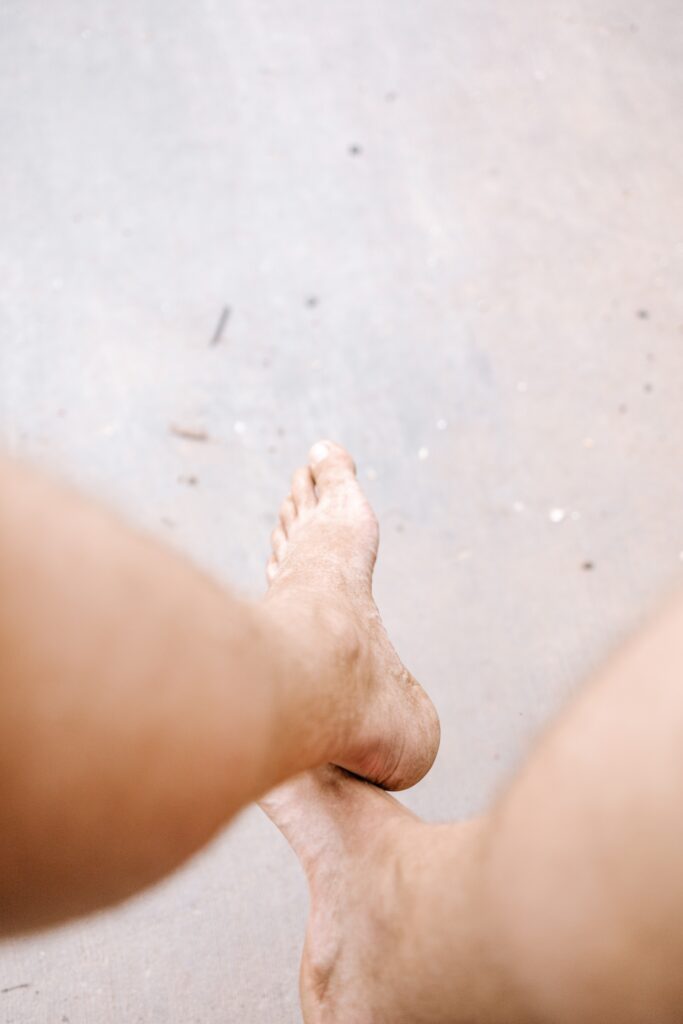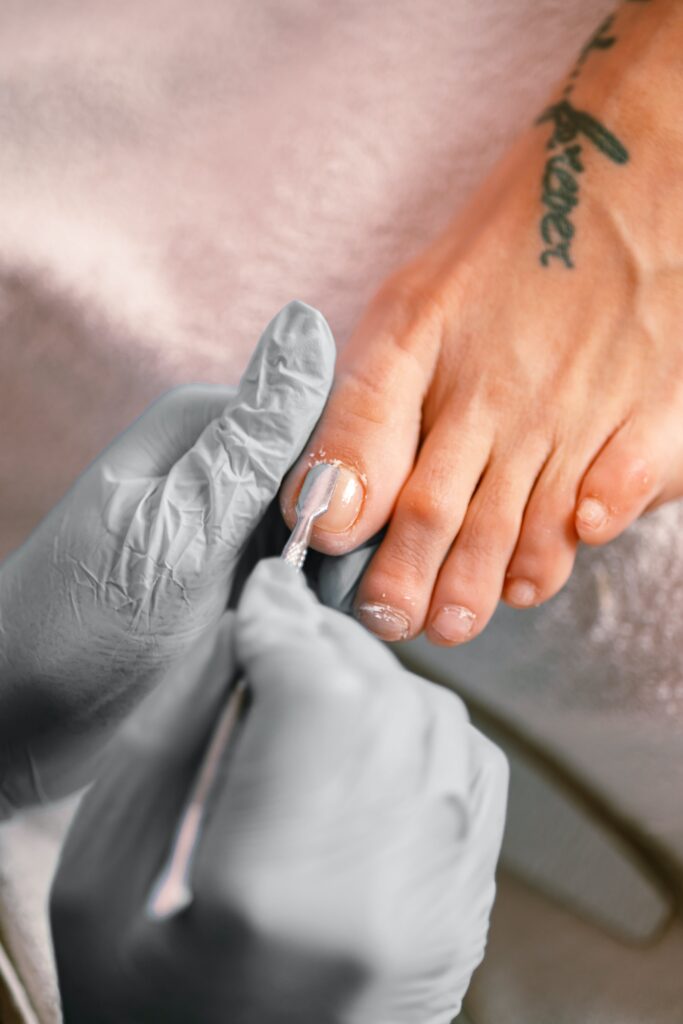What is Toenail Fungus?
You may have noticed one or more of your nails are slightly discolored. Instead of a healthy-looking toenail, it may appear white or yellow-brown in color. This can be a sign of toenail fungus.
Onychomycosis, or toenail fungus, is a common infection that occurs underneath the nail surface. If you’re suffering from toenail fungus, fungi have found their way between your toenail and your toenail bed. Toenail fungus isn’t confined to a single toe. It can occur on one toe or on many toes at the same time.
The thicker toenails fungal nails cause are often difficult to trim and can make walking painful when wearing shoes. If you’re suffering from toenail fungus, you’ll notice a progressive change in your toenail’s quality and color. It’s normal to feel embarrassed or upset about the discoloration and misshapen nature of a toenail(s) affected by this infection.

What Causes Toenail Fungus?
Anyone can get a fungal nail infection. Your toenails are especially vulnerable to fungi in damp areas where you are likely to be walking around barefoot. Think of your local swimming pool, locker rooms, gyms, and showers. Any injury to the nail bed, even pressure from your shoes, can make you more susceptible to infection.
A particular type of mold called a dermatophyte causes tinea unguium, which is the most common nail fungus. Dermatophytes cause 90% of all toenail fungal infections and need keratin to grow. Keratin is the main building block of your nails and is what makes them hard. This, in combination with the fact fungal infections grow best in dark, moist environments, means your feet and toenails are more susceptible to this particular fungus than other areas of your body.
There are a few factors that can make you more prone to fungal nail infections. If you:
- Suffer from chronic diseases like diabetes
- Have circulatory problems
- Have immune deficiency conditions
- Have had athlete’s foot in the past or have fungal skin infections on other parts of your body
- Have a skin condition like psoriasis that affects your nails
- Walk barefoot in damp public areas
- Have hyperhidrosis (a disorder that makes you sweat a lot)
- Have a toenail injury
Toenail fungus is a common condition, especially as you start to age! While toenail fungus affects approximately 1 in 10 (10%) people overall, that number jumps to 1 in 2 (50%) people for those older than 70.

What Are Common Symptoms of Toenail Fungus
Toenail fungus is often ignored because the infection can be present for many years without causing any pain to the patient. Symptoms of nail fungus can include a nail or nails that are:
- Thickened
- Brittle or ragged
- Discolored
- Cloudy in some spots
- Crumbling at the edges
- Misshapen
- Separated from the nail bed —leaving space between your nail and the skin underneath
- Smelly
- Cracked
What Can I Do at Home for My Fungal Toenails?
There are a few things you can do at home to help treat your fungal nails. Daily cleansing can help temporarily suppress mild toenail infections. Over-the-counter liquid antifungal agents may also help with fungal nails, however, these over-the-counter treatments may not prevent a fungal infection from coming back. It’s important to remember trying to get rid of the infection without the help of a qualified medical professional, like a podiatrist, can lead to more problems.
Should I See a Podiatrist for Fungal Nails?
The short answer is yes!
Some people like to try self-care steps when they first start to notice the signs of toenail fungus. These at-home options may clear mild cases of fungal toenails. However, it’s a good idea to see your local podiatrist if you notice your toenails are becoming increasingly discolored, misshapen, and thickened.
The earlier you seek professional care from your podiatrist, the greater your chance of success at getting your nails clear and back to normal.
It’s important to see your podiatrist if you’re experiencing swelling or pain around the nails, having difficulty walking, or if you’re bleeding around the infected nails. It’s especially important to see your podiatrist if you’re a diabetic and think you’re developing toenail fungus.
If you’re suffering from a severe case of nail fungus, it can be painful and cause permanent damage to your nails or lead to other serious infections that spread beyond your feet.

How to Diagnose and Treat Fungal Toenails
Luckily, it’s a straightforward process to determine if you’re suffering from a fungal toenail infection, and your podiatrist can do this in the early stages of infection by performing a lab test in which a small sample from underneath your nail is taken and analyzed or by performing a culture test.
You and your podiatrist will decide on the best course of action to clear your toenails of a fungal infection. Treatments can vary depending on the severity and nature of the infection.
Toenail fungus is known for being tricky to treat. You may need to treat toenail fungus for many months to get rid of it completely. And unfortunately, toenail fungus often comes back.
Treatment can include topical or oral medications, antifungal medications, and temporary or permanent removal of the infected nail. The most effective toenail fungus treatment for you will depend on your specific symptoms and situation, and your podiatrist will take several factors into consideration before recommending a treatment plan for you.
Unfortunately, it can be a long and frustrating process to completely clear up the infection. It’s important to remember toenails grow slowly, and it may take 12 to 18 months before you see the complete resolution of fungal nails, even with the correct treatment.
How Do I Prevent Toenail Fungus?
There’s no foolproof way to guarantee you won’t ever get toenail fungus. But here are a few steps you can take to help prevent it:
- Wear flip-flops in public showers, locker rooms, and around swimming pools. Don’t be barefoot in these places if you can help it!
- Keep your feet clean and dry. Fully dry your feet after a bath or shower.
- Don’t share nail clippers with other people.
- Keep your toenails short and clean.
- Don’t be aggressive with your nail trims. Trim your toenails straight across, and don’t round the edges!
- Change your socks regularly.
- Wear shoes that fit you correctly. Nothing too tight or loose around your toes.
- Clean your nail trimmer before each use
- If you’re a diabetic, make sure you’re following all foot care recommendations from your podiatrist or health care provider.
Why Choose a Foot and Ankle Surgeon?
Each of our doctors at Western Montana Foot and Ankle are board-certified surgical specialists. They have more advanced training than any other healthcare provider when it comes to your feet and ankles.
It’s key to remember you shouldn’t let a treatable condition like toenail fungus prevent you from wearing the shoes you want to wear. Toenail fungus is nothing to be ashamed of and one of our podiatrists at Western Montana Foot and Ankle can help you clear the infection.
